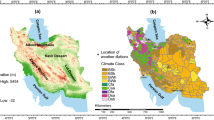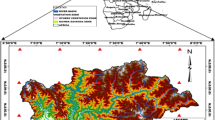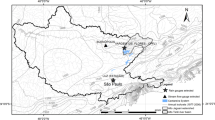Abstract
The escalating local impacts of climate change are a pressing global concern, particularly in regions vulnerable to global warming, like the Hindu Kush Himalayan region. Bhutan, recognised as one of the world’s most climate-vulnerable nations, faces extensive socio-economic damages due to climate change, posing significant recovery challenges. Climate change studies using satellite and hybrid data with Global Climate Models often amplify uncertainty, leading to exaggerated results. So, to understand the climate variability in Bhutan, we analysed historical temperature and precipitation using ground station data. We utilised the Mann–Kendall test and Sen’s slope analysis for trend assessment, continuous wavelet transform for periodicity detection, and cross wavelet transform for correlation analysis with atmospheric oscillations. The future climate projections were evaluated based on best-fit bias-corrected Coupled Model Intercomparison Project Phase 6 Global Climate Models data under the various Shared Socio‐Economic Pathways. The historical time series revealed, in general, a decreasing trend in rainfall. The maximum temperature showed a warming trend mostly above the elevation of 1000 m above mean sea level, while the minimum temperature showed a decreasing trend. However, the mean annual temperature and precipitation are expected to increase. The country could warm up from 1.7ºC to 3.3ºC under various Shared Socio‐Economic Pathways. The periodicity analysis of wavelets reveals that most stations showed higher covariance with the Indian Ocean Dipole and Elnino Southern Oscillation, followed by North Atlantic Oscillation, with 9–14 months periodicities. The findings of the past and future climate analysis presented in this study are expected to play a significant role in protecting the beautiful ecosystem of Bhutan as a whole. Additionally, the findings could assist policymakers in formulating adaptation strategies for addressing climate change impacts, enabling them to implement essential measures to transform Bhutan into a climate-resilient country.


















Similar content being viewed by others
Data availability
Data and material will be made available upon request.
References
Afzal M, Gagnon AS, Mansell MG (2015) Changes in the variability and periodicity of precipitation in Scotland. Theoret Appl Climatol 119(1–2):135–159. https://doi.org/10.1007/s00704-014-1094-2
Ahmed R, Wani GF, Ahmad ST, Sahana M, Singh H, Ahmed P (2021) A Review of Glacial Lake Expansion and Associated Glacial Lake Outburst Floods in the Himalayan Region. Earth Syst Environ 5(3):695–708. https://doi.org/10.1007/s41748-021-00230-9
Alexeeff SE, Nychka D, Sain SR, Tebaldi C (2018) Emulating mean patterns and variability of temperature across and within scenarios in anthropogenic climate change experiments. Clim Change 146:319–333. https://doi.org/10.1007/s10584-016-1809-8
Almazroui M, Saeed S, Saeed F, Islam MN, Ismail M (2020) Projections of Precipitation and Temperature over the South Asian Countries in CMIP6. Earth Syst Environ 4(2):297–320. https://doi.org/10.1007/s41748-020-00157-7
Amoako Johnson F, Hutton CW (2014) Dependence on agriculture and ecosystem services for livelihood in Northeast India and Bhutan: vulnerability to climate change in the Tropical River Basins of the Upper Brahmaputra. Clim Change 127:107–121. https://doi.org/10.1007/s10584-012-0573-7
Ashok K, Guan Z, Saji NH (2004) Individual and combined influences of ENSO and the Indian ocean dipole on the Indian summer monsoon. Am Meteorol Soc 17(16):3141–3155. https://doi.org/10.1175/15200442(2004)017%3C3141:IACIOE%3E2.0.CO;2
Chhetri R, Pandey VP, Talchabhadel R, Thapa BR (2021) How do CMIP6 models project changes in precipitation extremes over seasons and locations across the mid hills of Nepal? Theoret Appl Climatol 145(3–4):1127–1144. https://doi.org/10.1007/s00704-021-03698-7
Chettri N, Shrestha AB, Sharma E (2020) Climate change trends and ecosystem resilience in the Hindu Kush Himalayas. In: Dimri A, Bookhagen B, Stoffel M, Yasunari T (eds) Himalayan Weather and Climate and their Impact on the Environment. Springer International Publishing, pp 525–552. https://doi.org/10.1007/978-3-030-29684-1_25
Das J, Manikanta V, Umamahesh NV (2022) Population exposure to compound extreme events in India under different emission and population scenarios. Sci Total Environ 806:150424. https://doi.org/10.1016/J.SCITOTENV.2021.150424
Das L, Chandra B, Viswavidyalaya K, Akhter J, Kumar J, Kreate M (2016) Ensemble-based CMIP5 simulations of monsoon rainfall and temperature change over South Asia. 6:41-60. https://doi.org/10.13140/RG.2.1.1861.4160
Derdour S, Ghenim AN, Megnounif A, Tangang F, Chung JX, Ayoub AB (2022) Bias Correction and Evaluation of Precipitation Data from the CORDEX Regional Climate Model for Monitoring Climate Change in the Wadi Chemora Basin (Northeastern Algeria). Atmosphere 13:11. https://doi.org/10.3390/atmos13111876
Eghdamirad S, Johnson F, Sharma A (2017) How reliable are GCM simulations for different atmospheric variables? Clim Change 145:237–248. https://doi.org/10.1007/s10584-017-2086-x
FAO. (2011). Country profile-Bhutan. https://www.fao.org/3/ca0377en/CA0377EN.pdf
Gao L, Deng H, Lei X, Wei J, Chen Y, Li Z, Ma M, Chen X, Chen Y, Liu M, Gao J (2021) Evidence of elevation-dependent warming from the Chinese Tian Shan. Cryosphere 15(12):5765–5783. https://doi.org/10.5194/tc-15-5765-2021
Gaur S, Singh R, Bandyopadhyay A, Singh R (2023) Diagnosis of GCM-RCM-driven rainfall patterns under changing climate through the robust selection of multi-model ensemble and sub-ensembles. Clim Change 176(2):13. https://doi.org/10.1007/s10584-022-03475-z
Ghimire U, Srinivasan G, Agarwal A (2019) Assessment of rainfall bias correction techniques for improved hydrological simulation. Int J Climatol 39(4):2386–2399. https://doi.org/10.1002/joc.5959
Grinsted A, Moore JC, Jevrejeva S (2004) Application of the cross wavelet transform and wavelet coherence to geophysical time series. Nonlin Processes Geophys 11:561–566. https://doi.org/10.5194/npg-11-561-2004
Hamed MM, Nashwan MS, Shahid S, Ismail TB, Wang XJ, Dewan A, Asaduzzaman M (2022) Inconsistency in historical simulations and future projections of temperature and rainfall: A comparison of CMIP5 and CMIP6 models over Southeast Asia. Atmos Res 265:105927. https://doi.org/10.1016/j.atmosres.2021.105927
Hamed KH, Rao AR (1998) Hydrology A modified Mann-Kendall trend test for autocorrelated data. J Hydrol 204(1–4):182–196. https://doi.org/10.1016/S0022-1694(97)00125-X
Hrudya PH, Varikoden H, Vishnu R (2021) A review on the Indian summer monsoon rainfall, variability and its association with ENSO and IOD. Meteorol Atmos Phys 133(1):1–14. https://doi.org/10.1007/s00703-020-00734-5
Hu S, Hsu PC (2022) Drivers of elevation-dependent warming over the Tibetan Plateau. Atmos Ocean Sci Lett. https://doi.org/10.1016/j.aosl.2022.100289
Hunt KMR, Zaz SN (2022) Linking the North Atlantic Oscillation to winter precipitation over the Western Himalaya through disturbances of the subtropical jet. Clim Dyn. https://doi.org/10.1007/s00382-022-06450-7
Hussain A, Cao J, Hussain I, Begum S, Akhtar M, Wu X, Guan Y, Zhou J (2021) Observed Trends and Variability of Temperature and Precipitation and Their Global Teleconnections in the Upper Indus Basin, Hindukush-Karakoram-Himalaya. Atmosphere 12(8):973. https://doi.org/10.3390/ATMOS12080973
Kamruzzaman M, Shahid S, Roy DK, Islam ARMT, Hwang S, Cho J, Zaman MAU, Sultana T, Rashid T, Akter F (2022) Assessment of CMIP6 global climate models in reconstructing rainfall climatology of Bangladesh. Int J Climatol 42(7):3928–3953. https://doi.org/10.1002/joc.7452
Katzenberger A, Schewe J, Pongratz J, Levermann A (2021) Robust increase of Indian monsoon rainfall and its variability under future warming in CMIP6 models. Earth System Dynamics 12(2):367–386. https://doi.org/10.5194/esd-12-367-2021
Krishnan R, Sabin TP, Madhura RK, Vellore RK, Mujumdar M, Sanjay J, Nayak S, Rajeevan M (2019a) Non-monsoonal precipitation response over the Western Himalayas to climate change. Clim Dyn 52(7–8):4091–4109. https://doi.org/10.1007/s00382-018-4357-2
Krishnan R, Shrestha AB, Ren G, Rajbhandari R, Saeed S, Sanjay J, Syed Md A, Vellore R, Xu Y, You Q, Ren Y (2019b) Unravelling climate change in the hindu kush himalaya: rapid warming in the mountains and increasing extremes. In The Hindu Kush Himalaya Assessment. pp 57–97. https://doi.org/10.1007/978-3-319-92288-1_3
Kumar J, Das L, Akhter J, Benestad RE, Mezghani A (2017) Performance of CMIP3 and CMIP5 GCMs to Simulate Observed Rainfall Characteristics over the Western Himalayan Region. Am Meteorol Soc. https://doi.org/10.1175/JCLI-D-16-0774.s1
Kumar M, Fadhil Al-Quraishi AM, Mondal I (2021) Glacier changes monitoring in Bhutan High Himalaya using remote sensing technology. Environ Eng Res 26(1):1–8. https://doi.org/10.4491/EER.2019.255
Lhamo T, Chen G, Dorji S, Tamang TB, Wang X, Zhang P (2023) Trends in Extreme Precipitation Indices over Bhutan. Atmosphere 14(7):1154. https://doi.org/10.3390/atmos14071154
Lieber M, Chin-Hong P, Kelly K, Dandu M, Weiser SD (2022) A systematic review and meta-analysis assessing the impact of droughts, flooding, and climate variability on malnutrition. Global Public Health 17(1):68–82. https://doi.org/10.1080/17441692.2020.1860247. (Routledge)
Liu H, Duan K, Li M, Shi P, Yang J, Zhang X, Sun J (2015) Impact of the North Atlantic Oscillation on the Dipole Oscillation of summer precipitation over the central and eastern Tibetan Plateau. Int J Climatol 35(15):4539–4546
Mahagaonkar A, Wangchuk S, Ramanathan A, Tshering D, Mahanta C (2017) Glacier Environment and Climate Change in Bhutan—An Overview. J Climate Change 3(2):1–10. https://doi.org/10.3233/jcc-170010
Malla MK, Arya DS (2023) Event-based extreme precipitation variability analysis over a part of the Hindu Kush Himalayan region. Int J Climatol 43(9):4196–4219. https://doi.org/10.1002/joc.8082
Mendez M, Maathuis B, Hein-Griggs D, Alvarado-Gamboa LF (2020) Performance evaluation of bias correction methods for climate change monthly precipitation projections over Costa Rica. Water (Switzerland) 12:2. https://doi.org/10.3390/w12020482
Mishra SK, Jain S, Salunke P, Sahany S (2019) Past and future climate change over the Himalaya-Tibetan Highland: inferences from APHRODITE and NEX-GDDP data. Clim Change 156:315–322. https://doi.org/10.1007/s10584-019-02473-y
Moriasi DN, Arnold JG, Van Liew MW, Bingner RL, Harmel RD, Veith TL (2007) Model evaluation guidelines for systematic quantification of accuracy in watershed simulations. Trans ASABE 50:3. https://doi.org/10.13031/2013.23153
Napoli A, Crespi A, Ragone F, Maugeri M, Pasquero C (2019) Variability of orographic enhancement of precipitation in the Alpine region. Sci Rep 9:1. https://doi.org/10.1038/s41598-019-49974-5
NCHM. (2019). Analysis of Historical Climate and Climate Projection for National Center For Hydrology And Meteorology Royal Government Of Bhutanwww.nchm.gov.bt. www.nchm.gov.bt. https://www.nchm.gov.bt/attachment/ckfinder/userfiles/files/Analysis%20of%20Historical%20Climate%20and%20Climate%20Change%20Projection.pdf
Nie Y, Pritchard HD, Liu Q, Hennig T, Wang W, Wang X, Liu S, Nepal S, Samyn D, Hewitt K, Chen X (2021) Glacial change and hydrological implications in the Himalaya and Karakoram. Nat Rev Earth Environ 2(2):91–106. https://doi.org/10.1038/s43017-020-00124-w
NSB. (2022).
 National Statistics Bureau
National Statistics Bureau
 . https://www.nsb.gov.bt/wp-content/uploads/dlm_uploads/2022/10/Statistical-Yearbook-of-Bhutan-SYB-2022.pdf
. https://www.nsb.gov.bt/wp-content/uploads/dlm_uploads/2022/10/Statistical-Yearbook-of-Bhutan-SYB-2022.pdfPepin NC, Arnone E, Gobiet A, Haslinger K, Kotlarski S, Notarnicola C, Palazzi E, Seibert P, Serafin S, Schöner W, Terzago S, Thornton JM, Vuille M, Adler C (2022) Climate Changes and Their Elevational Patterns in the Mountains of the World. Rev Geophys 60:1. https://doi.org/10.1029/2020RG000730. (John Wiley and Sons Inc)
Raghavan SV, Hur J, Liong SY (2018) Evaluations of NASA NEX-GDDP data over Southeast Asia: present and future climates. Clim Change 148:503–518. https://doi.org/10.1007/s10584-018-2213-3
Rathinasamy M, Agarwal A, Sivakumar B, Marwan N, Kurths J (2019) Wavelet analysis of precipitation extremes over India and teleconnections to climate indices. Stoch Env Res Risk Assess 33(11–12):2053–2069. https://doi.org/10.1007/s00477-019-01738-3
Rhif M, Abbes A, Benfarah IR, Martínez B, Sang Y (2019) Wavelet transform application for/in non-stationary time-series analysis: A review. Appl Sci (Switzerland) 9:7. https://doi.org/10.3390/app9071345. (MDPI AG)
Rizzo R, Garcia AS, de Vilela VMFN (2020) Land use changes in Southeastern Amazon and trends in rainfall and water yield of the Xingu River during 1976–2015. Clim Change 162:1419–1436. https://doi.org/10.1007/s10584-020-02736-z
Romshoo SA, Marazi A (2022) Impact of climate change on snow precipitation and streamflow in the Upper Indus Basin ending twenty-first century. Clim Change 170:1–20. https://doi.org/10.1007/s10584-021-03297-5
Romshoo SA, Bashir J, Rashid I (2020) Twenty-first century-end climate scenario of Jammu and Kashmir Himalaya, India, using ensemble climate models. Clim Change 162:1473–1491. https://doi.org/10.1007/s10584-020-02787-2
Roy I, Tedeschi RG, Collins M (2019) ENSO teleconnections to the Indian summer monsoon under changing climate. Int J Climatol 39(6):3031–3042. https://doi.org/10.1002/JOC.5999
Rudraswamy GK, Manikanta V, Umamahesh N (2023) Hydrological assessment of the Tungabhadra River Basin based on CMIP6 GCMs and multiple hydrological models. J Water Clim Chang 14:1371–1394. https://doi.org/10.2166/wcc.2023.272
Saikh NI, Saha S, Sarkar D, Mondal P (2023) Rainfall trend and variability analysis of the past 119 (1901–2019) years using statistical techniques: A case study of Kolkata, India. Mausam 74:1093–1112. https://doi.org/10.54302/mausam.v74i4.5909
Sarkar D, Sarkar T, Saha S, Mondal P (2021a) Compiling non-parametric tests along with CA-ANN model for precipitation trends and variability analysis: A case study of Eastern India. Water Cycle 2:71–84. https://doi.org/10.1016/j.watcyc.2021.11.002
Sarkar Ajit, Saha S, Sarkar D, Mondal P et al (2021b) Variability and trend analysis of the rainfall of the past 119 (1901-2019) years using statistical techniques: a case study of Uttar Dinajpur, India. J Clim Change 7(2):49–61. https://doi.org/10.3233/JCC210011
Sen PK (1968) Estimates of the Regression Coefficient Based on Kendall’s Tau. J Am Stat Assoc 63:1379–1389. https://doi.org/10.1080/01621459.1968.10480934
Sharma V, Adhikari K (2022) Rainfall and rainy days trend and ENSO phenomena in Himalayan Kingdom of Bhutan. Acta Geophys 70:1855–1869. https://doi.org/10.1007/s11600-022-00839-y
Singh SP, Bassignana-Khadka I, Karky BS, Sharma E (2011) Climate change in the Hindu Kush-Himalayas: The state of current knowledge. ICIMOD, Kathmandu
Song YH, Chung ES, Shiru MS (2020) Uncertainty analysis of monthly precipitation in GCMs using multiple bias correction methods under different RCPs. Sustain (Switzerland) 12:18. https://doi.org/10.3390/su12187508
Sovacool BK, Linnér BO, Klein RJT (2017) Climate change adaptation and the Least Developed Countries Fund (LDCF): Qualitative insights from policy implementation in the Asia-Pacific. Clim Change 140:209–226. https://doi.org/10.1007/s10584-016-1839-2
Tawde SA, Singh C (2015) Investigation of orographic features influencing spatial distribution of rainfall over the Western Ghats of India using satellite data. Int J Climatol 35(9):2280–2293. https://doi.org/10.1002/joc.4146
Taxak AK, Murumkar AR, Arya DS (2014) Long term spatial and temporal rainfall trends and homogeneity analysis in Wainganga basin, Central India. Weather Clim Extrem 4:50–61. https://doi.org/10.1016/j.wace.2014.04.005
Thompson LG (2010) Climate change: The evidence and our options. Behavior Analyst 33(2):153–170. https://doi.org/10.1007/BF03392211
Tiwari R, Mishra AK, Rai S, Pandey LK (2023) Evaluation and projection of northeast monsoon precipitation over India under higher warming scenario: a multimodel assessment of CMIP6. Theoret Appl Climatol 151(1–2):859–870. https://doi.org/10.1007/s00704-022-04299-8
Torrence C, Compo GP (1998) A practicle guide for wavelet analysis. Bull Am Meteorol Soc 79:61–78. https://doi.org/10.1175/1520-0477(1998)079%3c0061:APGTWA%3e2.0.CO;2
Vaidya RA, Shrestha MS, Nasab N, Gurung DR, Kozo N, Pradhan NS, Wasson RJ (2019) Disaster risk reduction and building resilience in the Hindu Kush Himalaya. In The Hindu Kush Himalaya Assessment. pp 389–419. https://doi.org/10.1007/978-3-319-92288-1_11
Walsh JE, Ballinger TJ, Euskirchen ES, Hanna E, Mård J, Overland JE, Tangen H, Vihma T (2020) Extreme weather and climate events in northern areas: A review. Earth-Sci Rev 209:103324. https://doi.org/10.1016/j.earscirev.2020.103324. (Elsevier B.V)
Wester P, Mishra A, Mukherji A, Shrestha AB (2019) The Hindu Kush Himalaya assessment: mountains, climate change, sustainability and people. Springer Nature, p 627. https://doi.org/10.1007/978-3-319-92288-1
Xu J, Badola R, Chettri N, Chaudhary RP, Zomer R, Pokhrel B, Hussain SA, Pradhan S, Pradhan R (2019) Sustaining biodiversity and ecosystem services in the Hindu Kush Himalaya. In The Hindu Kush Himalaya Assessment. pp 127–165. https://doi.org/10.1007/978-3-319-92288-1_5
You Q, Chen D, Wu F, Pepin N, Cai Z, Ahrens B, Jiang Z, Wu Z, Kang S, AghaKouchak A (2020) Elevation dependent warming over the Tibetan Plateau: Patterns, mechanisms and perspectives. Earth-Sci Rev 210:103349. https://doi.org/10.1016/j.earscirev.2020.103349. (Elsevier B.V)
Acknowledgements
The first author is thankful to the Royal Civil Service Commission of Bhutan for providing the Nehru – Wangchuck Scholarship to work on this study at the Indian Institute of Technology Roorkee, India. The authors also thankfully acknowledge The National Center for Hydrology and Meteorology (NCHM) for providing observed hydrometeorological data for this study.
Funding
“The authors declare that no funds, grants, or other support were received during the preparation of this manuscript.”
Author information
Authors and Affiliations
Contributions
Phunsho Rinzin: Conceptualisation; methodology; writing – original draft; writing – review and editing; data curation; investigation; validation; visualisation; formal analysis. Mani Kanta Malla: Investigation; validation; formal analysis; supervision; writing – review and editing; conceptualisation; methodology. Dhyan Singh Arya: Investigation; validation; formal analysis; supervision; writing – review and editing; conceptualisation; methodology.
Corresponding author
Ethics declarations
Competing interests
The authors have no relevant financial or non-financial interests to disclose.
Additional information
Publisher's Note
Springer Nature remains neutral with regard to jurisdictional claims in published maps and institutional affiliations.
Supplementary Information
Below is the link to the electronic supplementary material.
Rights and permissions
Springer Nature or its licensor (e.g. a society or other partner) holds exclusive rights to this article under a publishing agreement with the author(s) or other rightsholder(s); author self-archiving of the accepted manuscript version of this article is solely governed by the terms of such publishing agreement and applicable law.
About this article
Cite this article
Rinzin, P., Malla, M.K. & Arya, D.S. Past and future climate variability analysis in bhutan. Theor Appl Climatol (2024). https://doi.org/10.1007/s00704-024-04973-z
Received:
Accepted:
Published:
DOI: https://doi.org/10.1007/s00704-024-04973-z





 National Statistics Bureau
National Statistics Bureau
 .
.